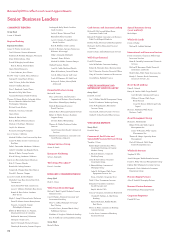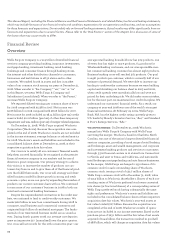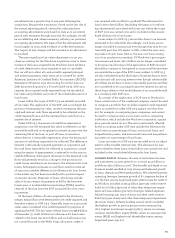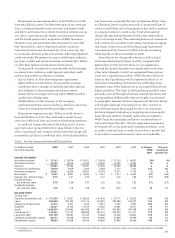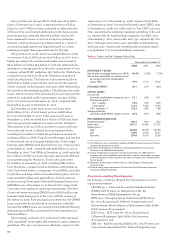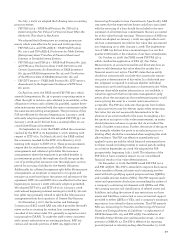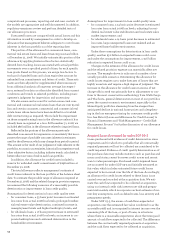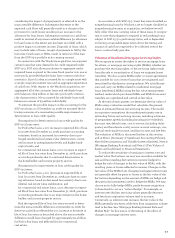Wells Fargo 2008 Annual Report Download - page 37
Download and view the complete annual report
Please find page 37 of the 2008 Wells Fargo annual report below. You can navigate through the pages in the report by either clicking on the pages listed below, or by using the keyword search tool below to find specific information within the annual report.
are refined over a period of up to one year following the
acquisition. Because the transaction closed on the last day of
the annual reporting period, certain fair value purchase
accounting adjustments were based on data as of an interim
period with estimates through year end. Accordingly, we will
be re-validating and, where necessary, refining our purchase
accounting adjustments. We expect that the refinements will
focus largely on loans with evidence of credit deterioration.
The impact of any changes will be recorded as an adjustment
to goodwill.
The more significant fair value adjustments in our pur-
chase accounting for the Wachovia acquisition were to loans.
Certain of the loans acquired from Wachovia have evidence
of credit deterioration since origination and it is probable
that we will not collect all contractually required principal
and interest payments. Such loans are accounted for under
American Institute of Certified Public Accountants (AICPA)
Statement of Position 03-3, Accounting for Certain Loans or
Debt Securities Acquired in a Transfer (SOP 03-3). SOP 03-3
requires that acquired credit-impaired loans be recorded at
fair value and prohibits carryover of the related allowance for
loan losses.
Loans within the scope of SOP 03-3 are initially recorded
at fair value. The application of the SOP, and accordingly the
process of estimating fair value, involves estimating the prin-
cipal and interest cash flows expected to be collected on the
credit-impaired loans and discounting those cash flows at a
market rate of interest.
Under SOP 03-3, the excess of cash flows expected at
acquisition over the estimated fair value is referred to as the
accretable yield and is recognized in interest income over the
remaining life of the loan, or pool of loans, in situations
where there is a reasonable expectation about the timing and
amount of cash flows expected to be collected. The difference
between contractually required payments at acquisition and
the cash flows expected to be collected at acquisition, consid-
ering the impact of prepayments, is referred to as the nonacc-
retable difference. Subsequent decreases to the expected cash
flows will generally result in a charge to the provision for
credit losses resulting in an increase to the allowance for loan
losses. Subsequent increases in cash flows result in reversal
of any nonaccretable difference (or allowance for loan losses
to the extent any has been recorded) with a positive impact
on interest income. Disposals of loans, which may include
sales of loans, receipt of payments in full by the borrower,
foreclosure or troubled debt restructurings (TDRs) result in
removal of the loan from the SOP 03-3 portfolio at its carry-
ing amount.
Of the $446.1 billion of loans acquired in the Wachovia
merger, $93.9 billion were determined to be credit-impaired and
therefore subject to SOP 03-3. Generally, loans on nonaccrual
status were considered to be credit-impaired for purposes of
applying the SOP. The fair value of these loans was $58.8 billion
at December 31, 2008. Wachovia’s allowance for loan losses
related to the loans was $12.0 billion and such allowance was
not carried forward to the Wells Fargo allowance, rather it
was reversed with an offset to goodwill. The allowance for
loan losses of $7.5 billion (excluding the impact of conform-
ing adjustments) associated with loans not within the scope
of SOP 03-3 was carried over and is included in the consoli-
dated allowance for loan losses.
Loans subject to SOP 03-3 are written down to an amount
estimated to be collectible. Accordingly, such loans are no
longer classified as nonaccrual even though they may be con-
tractually past due. We expect to fully collect the new carry-
ing values of such loans (that is, the new cost basis arising
out of our purchase accounting). Of Wachovia’s pre-acquisi-
tion nonaccrual loans, $20.0 billion are no longer considered
to be nonaccrual because of the application of SOP 03-3 and
$97 million continue to be reported as nonaccrual because they
are outside the scope of the SOP. Loans subject to SOP 03-3
are also excluded from the disclosure of loans 90 days or more
past due and still accruing interest even though substantially
all of them are 90 days or more contractually past due and they
are considered to be accruing because the interest income on
these loans relates to the establishment of an accretable yield
in accordance with SOP 03-3.
As a result of the application of SOP 03-3 to Wachovia’s
loans, certain ratios of the combined company cannot be used
to compare a portfolio that includes acquired credit-impaired
loans accounted for under SOP 03-3 against one that does
not, for example, in comparing peer companies, and cannot
be used to compare ratios across years such as comparing
2008 ratios, which include the Wachovia acquisition, against
prior periods, which do not. The ratios particularly affected
by the accounting under SOP 03-3 include the allowance for
loan losses as a percentage of loans, nonaccrual loans, and
nonperforming assets, and nonaccrual loans and nonperform-
ing assets as a percentage of total loans.
Loans not subject to SOP 03-3 are recorded net of an adjust-
ment to reflect market interest rates. The allowance for loan
losses related to these loans of $7.5 billion was carried over and
included in the consolidated allowance for loan losses.
SUMMARY RESULTS Revenue, the sum of net interest income
and noninterest income, grew 6% to a record $41.9 billion in
2008 from $39.4 billion in 2007. The breadth and depth of our
business model resulted in very strong and balanced growth
in loans, deposits and fee-based products. We achieved positive
operating leverage (revenue growth of 6%; expense decline of
1%), the best among large bank peers. Net income for 2008 of
$2.66 billion included an $8.14 billion (pre tax) credit reserve
build, $2.01 billion (pre tax) of other-than-temporary impair-
ment and $124 million (pre tax) of merger-related expenses.
Diluted earnings per share of $0.70 included credit reserve
build ($1.51 per share) and other-than-temporary impairment
($0.37 per share). Industry-leading annual results included
the highest growth in pre-tax pre-provision earnings (up
16%), highest net interest margin (4.83%), return on average
common stockholders’ equity (ROE), return on average total
assets (ROA) and highest total shareholder return among
large bank peers (up 2%).









